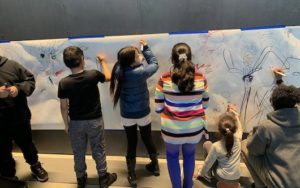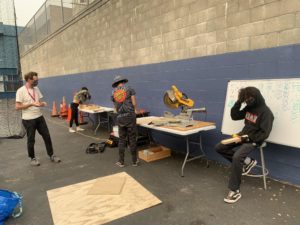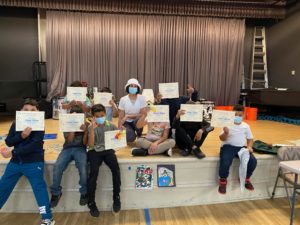In the pandemic-mad spring of 2020, many students struggled academically and emotionally as schools quickly moved to distance learning. Private entities set up pods, in which small groups of children could get assistance with distance learning, in person. For those who could afford them, these pods were valuable. For the rest, they were out of reach.
That made public education dramatically less equitable.
In response, Emily Garvie of the Clarence E. Heller Charitable Foundation raised the idea of organizing arts nonprofits to lead subsidized pods for students who lacked access to consistent arts learning and schoolwork support. At the Walter & Elise Haas Fund (W&EHF), we agreed this idea was worth putting into practice.

Pui Ling Tam, W&EHF Education Program Officer, organized virtual meetings with representatives from the Department of Children, Youth and Their Families (DCYF), the San Francisco Unified School District (SFUSD), other funders, and youth development and arts organizations. As the Fund’s Director of the Arts program, I reached out to test the interest of arts education nonprofits.
Soon after, DCYF launched its Community Hubs Initiative. These in-person programs sought to improve academic and social outcomes for students struggling to adapt to distance learning. And their success lent courage, knowledge, and momentum to our group effort to create arts pods.
Ultimately, arts organizations and youth development agencies joined to launch and sustain arts pods at ten sites in San Francisco, from September 2020 through the summer of 2021. By the end, the Walter & Elise Haas Fund had awarded $954,600 to support of this work — money specially allocated from the foundation’s endowment so as not to reduce regular program budgets.
To evaluate the project’s success, we commissioned Social Policy Research Associates (SPR) to look at enrollment data, survey students and parents, facilitate focus group conversations, and prepare case studies.
The work had been challenging, but this evaluation showed the results surpassed our hopes.
Arts pods overview
Arts pods took several forms. Some arts organizations managed day-long programs, while others partnered with a DCYF Community Hub to provide a morning of distanced learning assistance and an afternoon of arts instruction. They met with different frequencies and for differing lengths of time. One focused on architectural design and met twice a week in a parking lot, for example.
A total of 265 students participated in arts pods during the 2020-21 academic year.

- 91% were enrolled in an elementary grade
- 55% were male
- 44% were female
- 46% were African American
- 30% were Latinx
- 10% identified as of another race
- 8% identified as multi-racial
- 6% percent were Asian
COVID-19 placed great stress on organizations, so we kept the grant application process simple. In fact, we wrote the proposals ourselves, so organizations only had to check our work and provide budgets.
We began with small grants because we did not know if the pandemic and/or health guidelines would make proceeding impractical. As moving forward became possible, we amended initial grants to extend their duration.
Challenges
Arts pods served children enrolled across several different grade levels, at multiple schools. That meant the timing of participants’ school days differed, presenting complex scheduling challenges. Teaching artists had to design lessons that worked well for students of different ages. Further, facilities designed for other purposes had to be adapted for use as classrooms
Adhering to changing health and safety guidelines was also difficult. As the children formed friendships, it grew harder to keep them apart. Jo Kreiter of Flyaway Productions noted, “They hug you, they cry, the (required) six-feet (of) distance is hard to maintain with small children.”
Teaching artists were called upon to serve as mental health counselors at times, working outside of their areas of expertise.
Student outcomes

Educators leading virtual classrooms lamented feeling disconnected from their students. In contrast, many art pods took on the feel of a family. Over time, teaching artists noticed meaningful change in the talkativeness of students and their willingness to engage with teachers and each other.
Arts education made a quantifiable difference in students’ happiness, confidence, and learning. Surveys found that 86% of youth reported that they had more fun since they participated in their arts pod; 95% indicated that they had the opportunity to try something new in the arts; and 82% reported that they enjoyed their Community Hub experiences more because of the arts integration. Further, 71% of respondents felt more confident about their schoolwork.
Parents concurred: 93% percent of parents responding to surveys agreed that participating in arts activities was an important part of their children’s Community Hub experience, and 100% agreed that their children learned something new about art. Of respondents, 90% said their child was doing better emotionally because of the program.
Benefits to teaching artists
Arts pod teaching artists reported that they had time for meaningful engagement with their students, in contrast to many after-school teaching settings. They were able to develop their craft as teachers and were paid well to do so.
Participating artists also felt good about helping their communities. Krissy Keefer of Dance Brigade observed, “It made us all feel – especially during the first number of months – that we were doing something of significance.”
Other outcomes
In conversations and thank you letters, parents shared that arts pods and Community Hubs helped them to continue working, as they gained access to childcare and instructional support. Organizations formed lasting partnerships through the arts pods. As grantmakers, we got to know our grantees better.
The grantmaking
This project would not have been possible without DCYF’s major investment in Community Hubs. We are thankful to the Clarence E. Heller Charitable Foundation and The William and Flora Hewlett Foundation for joining the Walter & Elise Haas Fund with grant support for this work.
Sylvia Sherman of the Community Music Center observed, “Moments of coming together as a community and making up something together can be very powerful. There was real power in bringing people together.” The idea for the arts pods came from funders, but the project was only successful because multiple parties worked together.
In the words of Joanna Haigood of Zaccho SF, “This was a huge expression of love in a time of chaos.” To all who participated, we are profoundly grateful for your love and courage.

